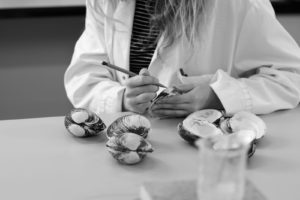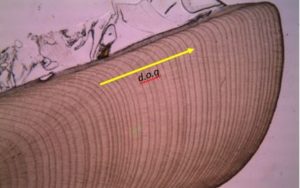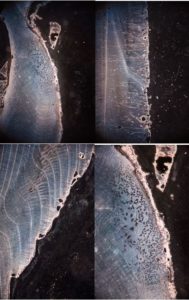Author – Sarah Holmes, PhD Researcher – Geography and Earth System Science

Photograph by Thom Holmes [thomholmes.co.uk].
Admittedly, telling people that my PhD research is using clams doesn’t always get “ooo’s” and “aah’s” that perhaps my fellow researchers working on whales and dolphins might get, but before you write me off as having a boring PhD, let me tell you a few…
**CLAM FACTS**
- Clams are the oldest animal known to science. Certain species are extremely long-lived. In 2006, scientists at Bangor University (these scientists have now moved to the University of Exeter, Penryn Campus) found a clam that was 507 years old. 507! That means this humble little mollusc (see picture above) was around when Shakespeare was putting pen to paper, when Henry VIII was beheading wives, when your great-great-great-great-great grandparents were born!
- Clams can record information about the environment in their shells. Certain species form annual growth bands on their shells, just like tree rings. During winter months, the clams grow more slowly and build up a denser layer of shell that looks like a defined band under the microscope (see picture below). Just like trees, the amount a clam (and so its shell) grows depends on the environment it lives in. In general, warm temperatures and plenty food (e.g. algae) means lots of growth and so a wide growth band. The opposite is true in less favourable conditions such as low temperatures or lack of food. As you may already know, using tree records in this way is called dendrochronology; using clam records is called sclerochronology.

Microscope image (25x mag.) of acetate peel of internal portion (umbo) of clam shell (species Glycymeris glycymeris). Clear growth bands visible, yellow line shows direction of growth (d.o.g).
- Clams in the same area grow synchronously. Since clam growth is affected by environment, it makes sense that clams from the same location (that are affected by the same environmental conditions) have very similar growth patterns. This means that it is possible to match up and combine the growth records of multiple clams to create what is called a ‘master sclerochronology’ – you can even incorporate ‘dead-collected’ clams that have an unknown date of death.
Cool, right? Well even more interestingly, these features mean that clams are an extremely valuable proxy* for the marine environment and are therefore of great interest to climate scientists like me. Previous research has shown that the clams are recording a multitude of environmental information in their shells such a sea water temperature, the amount of plankton present in the water and even large-scale climate variability such as North Atlantic Oscillation (which is like a measure of storminess in Northern Europe). Researchers can therefore (to an extent) reconstruct past ocean conditions using these records.

Scientists generally use shelf sea models** (of places like the North Sea) to predict future change, however to check if these models are representing reality correctly, they must be compared or ‘validated’ with these limited observed measurements.
Therefore, for the first time, my research is attempting to combine the records of long-lived clams with ocean models in order to better understand past and future change in the North Sea. The aim is twofold – first, to use the clam records to better validate the model and second, to use the model to give greater insight into the factors controlling clam growth in order to better interpret these proxy records.
So, I think we can all agree, this humble little clam is pretty exciting and could hold the key for better predictions of future ocean climate change – not bad for a squidgy, slimy lump that doesn’t even have a brain!
*Proxies are indirect measurements of the environment preserved in natural recorders of climate variability such as tree rings, pollen, ice cores or the rings on marine clams.
** Models are mathematical representations of the real world. Ocean models such as the one I am using (the European Regional Seas Ecosystem Model (ERSEM)) attempt to quantitively describe the physics, chemistry and biology of the shallow ocean that surrounds Europe (known as the Northwest European shelf seas).
#ExeterMarine is an interdisciplinary group of marine related researchers with capabilities across the scientific, medical, engineering, humanities and social science fields. If you are interested in working with our researchers or students, contact Michael Hanley or visit our website!
